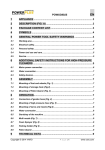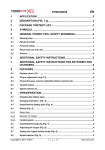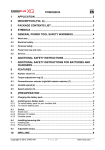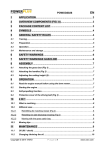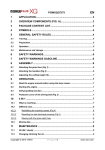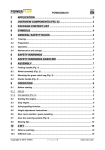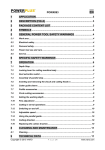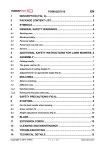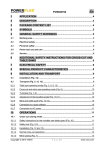Download VARO POWXG9007 high-pressure cleaner
Transcript
POWXG9007 EN 1 APPLIANCE .................................................................................... 3 2 DESCRIPTION ................................................................................ 3 3 PACKAGE CONTENT LIST............................................................ 3 4 SYMBOLS ....................................................................................... 4 5 GENERAL POWER TOOL SAFETY WARNINGS ......................... 4 5.1 Working environment ............................................................................................ 4 5.2 Personal safety ...................................................................................................... 4 5.3 Correct use and care ............................................................................................. 5 6 STANDARDIZED SAFETY WARNINGS FOR GASOLINE HIGH PRESSURE WASHERS.................................................................. 6 7 SAFETY WARNINGS GASOLINE .................................................. 6 8 SAFETY FEATURES ...................................................................... 6 8.1 Thermal relief valve ............................................................................................... 6 8.2 Safety lock off latch ............................................................................................... 6 9 ASSEMBLY INSTRUCTIONS ......................................................... 7 9.1 Attach handle and hook ........................................................................................ 7 9.2 Installing the wheels .............................................................................................. 7 9.3 assembly of the bobbin ........................................................................................ 7 9.4 Assembling the bobbin lock ................................................................................. 7 9.5 Using the bobbin lock ........................................................................................... 8 10 BEFORE OPERATION ................................................................... 8 10.1 Add oil to the engine crankcase ........................................................................... 8 10.2 Add fuel to fuel tank .............................................................................................. 8 10.3 Connect high pressure hose to spray gun and pump. ........................................ 9 10.4 High pressure lance safety lock ........................................................................... 9 10.5 Connecting the hose ............................................................................................. 9 10.6 Adjusting the spray pattern ................................................................................ 10 10.6.1 0° nozzle (colored red) ........................... ................................................................ 10 10.6.2 15° nozzle (colored yellow) ....................... ............................................................. 10 10.6.3 40° nozzle (colored white)........................ .............................................................. 10 10.6.4 Low pressure nozzle (colored black) ...................................................................... 10 Copyright © 2013 VARO NV P a g e |1 www.varo.com POWXG9007 EN 10.7 Connect the nozzle .............................................................................................. 11 10.8 Using the detergent facility ................................................................................. 11 11 OPERATING INSTRUCTIONS ..................................................... 11 11.1 Pressure washer location.................................................................................... 11 11.2 Start-up procedure .............................................................................................. 12 11.3 Start engine .......................................................................................................... 12 11.4 Stop the engine .................................................................................................... 13 12 TECHNICAL DATA ....................................................................... 14 13 SOUND EMISSION ....................................................................... 14 14 CLEANING AND MAINTENANCE ............................................... 15 14.1 Clearing a blockage ............................................................................................. 15 14.2 Routine maintenance........................................................................................... 15 14.2.1 Spark plug ............................................................................................................. 15 14.2.2 Engine oil replacement .......................................................................................... 15 14.2.3 Air filter .................................................................................................................. 16 14.2.4 Fuel tank filter ........................................................................................................ 16 15 STORAGE ..................................................................................... 16 16 PREPARATION FOR WINTER AND LONG TERM STORAGE .. 16 17 TROUBLE SHOOTING ................................................................. 17 18 WARRANTY .................................................................................. 17 19 ENVIRONMENT ............................................................................ 18 20 DECLARATION OF CONFORMITY ............................................. 18 Copyright © 2013 VARO NV P a g e |2 www.varo.com EN POWXG9007 GASOLINE PRESSURE WASHER POWXG9007 1 APPLIANCE Your gasoline high pressure cleaner has been designed for outdoors cleaning. Cleaning of: machines, vehicles, structures, tools, facades, terraces, gardening tools,… Danger! Risk of injury! Follow the respective safety regulations when operating at gas stations or other dangerous areas. Please do not let mineral oil contaminated waste water reach soil, water or the sewage system. Perform engine cleaning and bottom cleaning therefore only on specified places with an oil trap. Warning! Read this manual and the general safety instructions carefully before using the machine, for your own safety. 2 DESCRIPTION Picture 1 1. Handle 2. Hose Reel 3. High pressure hose (12m) 4. Trigger gun 5. Safety lock 6. Lance Hook 7. Nozzles 8. Accessory Tray 9. Carriage bolts 10. Air filter 11. Fuel tank 12. Exhaust silencer 13. Wheel 14. Engine 15. Spray wand 16. Recoil starter cord 17. Engine recoil starter Picture 2 18. Throttle control level 19. Choke 20. Fuel lever Picture 3 21. High pressure outlet 22. Water inlet connector 23. Detergent filter 24. Detergent suction tube 25. Oil fill cap 26. ON/OFF switch 3 PACKAGE CONTENT LIST Remove all packaging materials. Remove remaining packing and package inserts (if included). Check that the package contents are complete. Check the appliance, the power cord, the power plug and all accessories for transportation damage. Keep the packing materials as far as possible till the end of the warranty period. Dispose it into your local waste disposal system afterwards. WARNING: Packaging materials are not toys! Children must not play with plastic bags! Danger of suffocation! Pneumatic Tire (2) Gun (1) Lance (1) High Pressure hose (12m) Hose Bobbin Assembly (1set) Water Inlet Connecter (1) Copyright © 2013 VARO NV P a g e |3 Spark Plug Spanner (1) Nozzle Cleaning Tool (1) 5mm Hex Key (1) 4mm Hex Key (1) 8-10 Wrench (1) 10-13 Wrench (1) www.varo.com EN POWXG9007 Gun Shelf Assembly (1set) Operating Instruction manual (1) Manual of Engine (1) If any parts are missing or damaged, please contact your dealer. 4 SYMBOLS Warning danger The jet must not be directed at persons, pets, live electrical equipment or the appliance itself. Read manual before usage! Engine will not start or will shut down if the oil level is low. Flammable, do not smoke near the pressure washer. Wear ear protection Wear eye protection Wear gloves 5 GENERAL POWER TOOL SAFETY WARNINGS Read all safety warnings and all instructions. Failure to follow all warnings and instructions may result in electric shock, fire and/or serious injury. Save all warnings and instructions for future reference. The term "power tool" in the warnings refers to your mains operated (corded) power tool or battery operated (cordless) power tool. 5.1 Working environment Store the pressure washer in a well ventilated area with the fuel tank empty. Fuel should not be stored near the pressure washer. Equipment must be placed on a firm, supporting surface. Outdoors use only, never operate in an enclosed space, exhaust fumes are dangerous. Place the pressure washer away from cleaning site during operation. Keep children and bystanders away while operating a power tool. This appliance must be attended during operation. 5.2 Personal safety Stay alert, watch what you are doing and use common sense when operating a power tool. A moment of inattention while operating the power tools may result in serious personal injury. Wear safety goggles while operating. Small particles may fly out while spraying. Always wear ear protection to cut noise. Dress safely in long pants and wear boots or shoes. Other protective equipment is advisable when using chemicals, cleaning detergents or other corrosive or abrasive substances. Do not overreach. Keep proper footing and balance at all times. This enables better control of the power tool in unexpected situations. Do not operate pressure washing equipment if you have consumed alcohol or taken medication. Copyright © 2013 VARO NV P a g e |4 www.varo.com POWXG9007 EN Remove the spark plug or cable from the spark plug to prevent accidental starting. When not in use, or prior to detaching the high pressure hose. Do not ware loose clothing, jewellery or anything that may be caught in the engine. Keep pets, children and bystanders a safe distance away from your work area. A minimum of 50 feet is recommended. Never point or aim the gun at yourself or anyone else. Never put your hand, fingers or body directly in front of the spray nozzle. Do not smoke near the pressure washer. 5.3 Correct use and care Do not force the power tool. Use the correct power tool for your application. The correct power tool will do the job better and safer at the rate for which it was designed. Do not use the power tool if the switch does not turn it on and off. Any power tool that cannot be controlled with the switch is dangerous and must be repaired. Disconnect the plug from the power source before making any adjustments, changing accessories, or storing power tools. Such preventive safety measures reduce the risk of starting the power tool accidentally. Store idle power tools out of the reach of children and do not allow persons unfamiliar with the power tool or these instructions to operate the power tool. Power tools are dangerous in the hands of untrained users. Never operate under these conditions: − A noticeable change in engine speed. − A noticeable loss of pressure. − The engine misfires. − Smoke or flames are present, enclosed compartment. − Excessive vibration. − Rain or inclement weather. Keep the pressure washer clean and free of oil, mud and other foreign matter. Water spray must never be directed towards any electric wiring or directly towards the pressure washer. Use both hands to control the wand. Do not allow the hose to come in contact with hot muffler. Do not touch nozzle or water spray while operating. Do not fill the engine with gasoline when the engine is running, hot or near an open flame. Do not smoke Only approved hoses and nozzles should be used. The trigger gun must not lie jammed in position during operation. Never lay knots or kink in the high pressure hose. All hose connections must be properly connected. Prior to starting the pressure washer in cold weather, be sure ice has not formed in any part of the equipment. To prevent accidental discharge of high pressure water, the safety latch on the trigger should be engaged whenever the pressure washer is not in use (refer to operating instruction). Do not run the pressure washer for more than five minutes without depressing the trigger. The Pump might get damaged. Check the fuel system periodically for leaks or signs of deterioration such as chafed or spongy hose or missing clamps, or damaged tank or cap. All defects should be corrected before operation. Do not touch hot muffler. Service, operate and refuel under the following conditions: − Good ventilation. − Refuel the pressure washer in a well lighted area. Copyright © 2013 VARO NV P a g e |5 www.varo.com EN POWXG9007 − − − − Avoid fuel spills and never refuel while the pressure washer is running. Avoid an ignition source when refuelling. Use unleaded free fuel Do not use damaged high-pressure hose. 6 STANDARDIZED SAFETY WARNINGS FOR GASOLINE HIGH PRESSURE WASHERS WARNING: This appliance has been designed for use with the cleaning agent supplied or recommended by the manufacturer. The use of other cleaning agents or chemicals may adversely affect the safety of the appliance. WARNING: Do not use the appliance within range of persons unless they wear protective clothing. WARNING: High Pressure jets can be dangerous if subject to miss use. The jet must not be directed at persons, live electrical equipment or the appliance itself. Do not direct the jet against yourself or others in order to clean shoes or clothes. To ensure appliance safety, use only original spare parts from the manufacturer or approved by the manufacturer. WARNING: High Pressure hoses, fittings, and couplings are important for the safety of the appliance. Use only fittings and couplings recommended by the manufacturer. Do not use the appliance, if a supply cord or important parts are damaged, e.g. safety devices, high pressure hoses, trigger gun. WARNING: Incorrect fuels shall not be used as they may prove hazardous. WARNING: Do not use combustion engine powered appliances indoors unless adequate ventilation is assessed by national labour authorities. WARNING: Ensure that any exhaust emissions are not in the vicinity of air intakes. 7 SAFETY WARNINGS GASOLINE WARNING: Use extra care in handling fuels. They are flammable and the vapours are explosive. The following points must be observed. Use only an approved container. Never remove the fuel cap or add fuel with the power source running. Allow engine exhaust components to cool before refuelling. Do not smoke. Never refuel the machine indoors. Never store the machine or fuel containers inside, where is an open flame, such as a water heater. If fuel is spilled, do not attempt to start the power source, but move the machine away from the area of spillage before starting. Always replace and securely tighten the fuel cap after refuelling. If the tank is drained, this should be done outdoors. 8 SAFETY FEATURES 8.1 Thermal relief valve A thermal relief valve is provided to protect the pump from overloading if the spray gun is closed for an extended length of time or the nozzle becomes plugged. However, it is intended to be used as a backup system and avoid the overheating of the pump. Switch the pressure washer "OFF", if it will not be used for longer than five minutes. This reduces wear, prevents fuel consumption and extends the live of the pump by avoiding heat. 8.2 Safety lock off latch To prevent accidental discharge of high pressure water, the safety latch on the trigger should be engaged whenever the pressure washer is not in use (refer to operating instruction). Copyright © 2013 VARO NV P a g e |6 www.varo.com EN POWXG9007 9 ASSEMBLY INSTRUCTIONS Remove all packaging materials from the unit. Check the main unit, its components and all accessories for loss and transport damages. 9.1 Attach handle and hook Attach the handle (picture 1, part 1) and accessory tray (picture 1, part 8)to the frame of the pressure washer. Insert carriage bolts (picture1, part 9) through holes from outside of unit and attach a knob from inside of unit. Tighten by hand. Fit the lance hook (picture 1, part 6) to the upper handle 9.2 Installing the wheels Before you fix the wheels (picture 1, part 13) you have to loosen a screw to take out the axle. Fit a wheel to the axle and secure using the locking nut provided. 9.3 1. 2. 3. 4. 5. 6. 7. 8. 9. assembly of the bobbin Place the bobbin on the level surface; put the water connector into one side of bobbin. Tighten its connection by a screw and bolt. Connect the high pressure hose ((picture 1, part 3)to the water connector. Put the bush onto another side of bobbin. Then put the side handle into this side of bobbin. Tighten its connection by a screw and bolt. Put the whole bobbin onto the upper frame, and tighten the clips. Connect the pressure hose which is connected with water connector to the pump water outlet. Connect the pressure hose which is on the bobbin to the spray gun. 9.4 1. 2. 3. 4. Assembling the bobbin lock Put the washer onto the lock pin seat, then through the tube and tighten the nut. Put the lock pin through the spring first, then through the lock pin seat. Fit the pull ring on the lock pin. Now the bobbin lock is finished. Copyright © 2013 VARO NV P a g e |7 www.varo.com EN POWXG9007 9.5 Using the bobbin lock 1. Lock Pull the lock pin and rotate to the position where the pull ring can get into the lock pin seat. Then release, and let the lock pin into the howl on the bobbin. 2. Unlock Pull the lock pin out of the lock pin seat and rotate about 90°, then release. 10 BEFORE OPERATION To prepare your pressure washer for operation, you will need to perform these tasks: Add oil to engine crankcase. Add fuel to fuel tank. Connect high pressure hose to spray gun and pump. Connect water supply to pump. Attach nozzle extension to spray gun. Note: the engine and pump on your new pressure washer will often have an improved performance after a break of several hours. 10.1 Add oil to the engine crankcase Do not attempt to start the pressure washer without filling the engine crank case (picture 3, part 25) with the proper amount and type of oil (see technical data). In delivery status the pressure washer has no oil inside the engine crank case. Operating the unit without oil will cause engine damage. Place the machine on a level surface and remove the oil filler cap. Add engine oil to at least half of the dipstick 10.2 Add fuel to fuel tank The pressure washer is powered by a four-stroke engine (picture 1, part 14), which uses unleaded petrol fuel. Use a suitable funnel to fill in the fuel to the engines fuel tank (picture 1, part 11). Do not spill any fuel or overfill the tank. The fuel tank should not be filled above the top of the fuel filter. Copyright © 2013 VARO NV P a g e |8 www.varo.com POWXG9007 10.3 EN Connect high pressure hose to spray gun and pump. Fit the lance to the gun (picture 1, part 4). Grip the end of the gun and screw the lance onto the gun ensuring it is tight. Do not over tighten as this could damage both the connectors. Connect the high pressure hose connector to the connector on the underside of the gun assembly ensuring that it is tight. Do not over tighten as this could damage both the connectors. 10.4 High pressure lance safety lock In order to prevent accidental operation of the high-pressure lance, the gun is fitted with a safety lock. To engage the safety lock (picture 1, part 5) release the trigger and engage the safety lock between the trigger and the gun body. 10.5 Connecting the hose The water inlet connector is fitted with a particle filter and if not fitted must be fitted prior to use. Do not run the unit without filter. Based on the water quality the filter must be checked and cleaned from time to time. In case there are dirt particles in the water supply, the filter must be cleaned before each use. Otherwise the performance of the unit will be decreased or the pump might get damaged. Screw the male, water inlet connector onto the pressure washer water inlet. (picture 3, part 22) Fit a female hose connector to your hose pipe and then connect the female connector onto the male connector. Copyright © 2013 VARO NV P a g e |9 www.varo.com POWXG9007 EN Connect the high-pressure hose to the delivery pipe outlet (picture 3, part 21). Turn on the water supply and squeeze the gun trigger (picture 1, part 4) until the water flows in a steady stream through the lance. Do not use water which exceeds 40°C. 10.6 Adjusting the spray pattern Warning: Always ensure that the wand is fixed correctly. Otherwise it could be injected under high pressure when operating the gun, possibly causing injury or damage. You have the choice of 4 different colour coded nozzles (picture 1, part 7) giving you different spray patterns to choose from: 10.6.1 0° nozzle (colored red) This nozzle delivers a pinpoint stream and is extremely powerful. It covers a very small area of cleaning. This nozzle should only be used on surface that can withstand this high pressure such as metal or concrete. Do not use on wood. 10.6.2 15° nozzle (colored yellow) This nozzle delivers a powerful 15 degree spray pattern for intense cleaning of small areas. This nozzle should only be used on areas that can withstand the high pressure from this nozzle. 10.6.3 40° nozzle (colored white) This nozzle delivers a 40 degree spray pattern and a less powerful stream of water. It covers a wide area of cleaning. this nozzle should be used for most general cleaning jobs. 10.6.4 Low pressure nozzle (colored black) This nozzle is used to apply chemicals or cleaning solutions. It has the least power stream. Note: Due to material and workmanship differences high pressure streams can damage patio paving slabs. Try on a small test area first. If necessary adjust the pressure by changing nozzles or slowing down the engine speed Copyright © 2013 VARO NV P a g e | 10 www.varo.com POWXG9007 10.7 EN Connect the nozzle Connect the nozzle to the lance using the quick release connector this allows the quick and easy changing of nozzles. To connect a nozzle slide the collar back towards the gun, push the nozzle into the end of the lance. Release the collar to lock the nozzle into position. To disconnect a nozzle slide the collar back towards the gun, the nozzle can now be removed. Note: please be sure that you crosscheck the correct connection of the nozzle. Warning: the nozzle is not properly fixed when the collar doesn’t slide back. Push the nozzle with high force into the opening, otherwise the collar doesn’t slide back by itself and the nozzle is shot out. 10.8 Using the detergent facility Fill a suitable container with pressure washer detergent. Do not use washing up liquid as it contains salt. We recommend the use of a good quality pressure washer detergent for use with this pressure washer. Please follow the instructions on the container. Most automobile detergents are a combination of a detergent and a wax solution, (wash/wax liquid). These tend to be a thick viscous liquid. The viscosity (thickness) of the detergent will increase in cold weather. It is recommended that this type of detergent is diluted with warm water before filling the container. When using combination wash and wax solutions we recommend that they are diluted before use. As a general guide we would recommend a dilution rate of 50/50. However a trial and error process would determine the ideal dilution rate for a particular detergent. Notes: A thick viscous detergent would not flow freely from the detergent tank and the residue would cause a blockage in the detergent flow system. After using the detergent facility it should be flushed out thoroughly using copious amounts of water. To activate detergent delivery, fit the black low pressure nozzle to the end of the lance. Submerge the end of the detergent suction tube (picture 3, part 24) into your container of pressure washer detergent. Suction and mixing will occur automatically as the water flows through the pump. 11 OPERATING INSTRUCTIONS 11.1 Pressure washer location Locate the pressure washer on a solid and level surface so that the engine and pump crankcase oil lubricate components properly. Avoid areas where puddles are pounded. Slippery surfaces can cause injuries.. Locate the machine in a well-ventilated area and away from flammable materials or fumes. Be sure ventilation warnings are observed. Keep pressure washer at least 18”away from flammable materials. Copyright © 2013 VARO NV P a g e | 11 www.varo.com POWXG9007 EN Locate the machine in a way, that the operator has easy access to the pressure washer and its controls. Locate the machine so that it is protected from external damage. To prevent damage and excessive hose wear; locate the pressure washer so that the hose does not cross traffic areas. 11.2 Start-up procedure Remove all dirt or foreign matter from the gun outlet and the male connector. Insert the nozzle into the gun. Start engine. Warning: lf the wand is not securely locked into place. It could be injected under high pressure when operation the gun, possibly causing injury or damage. 11.3 Start engine Turn the fuel lever (picture 2, part 20) to the ON position. Set the choke lever (picture 2, part 19) to the ON position. Turn the engine ON/OFF switch (picture 3, part 26) to the ON position Hold down the engine firmly with one hand on the frame. With the other hand grip the recoil starter cord (picture 1, part 16) handle and pull slowly until resistance is felt indicating that the recoil starter (picture 1, part 17) is engaged. When resistance is felt pull the cord sharply. Continue this procedure until the engine starts. Copyright © 2013 VARO NV P a g e | 12 www.varo.com EN POWXG9007 When the engine has been successfully started and is running smoothly return the choke lever (picture 2, part 19) to the OFF position When the engine is running, the speed can be adjusted by moving the throttle control lever (picture2, part 18). When you slide the throttle to the right, the engine will have a lower rotation speed. To obtain a higher rotation speed you have to slide the throttle more to the left. 11.4 Stop the engine To stop the engine, turn the engine ON/OFF switch (picture 3, part 26) to the OFF position. Warning! After the engine has stopped turn off the water supply to the pressure washer and release all remaining pressure by operating the trigger until there is no more pressure in the appliance and the water flow stops, secure the trigger with the safety lock (picture1, part 5) to prevent unintentional operation. Disconnect the lance and drain any residual water from all hoses (picture 1, part 3), carefully coil the hoses ensuring that they are not kinked or twisted and check for any other damage, replace any damaged hoses. Damaged hoses can be dangerous under pressure. When the engine has stopped and before storage, turn the fuel lever (picture 2, part 20) to the OFF position Copyright © 2013 VARO NV P a g e | 13 www.varo.com EN POWXG9007 12 TECHNICAL DATA MOTOR Maximum torque at 3600 min-1 Operating Speed Fuel tank Fuel Engine Type Starting System Displacement WATER CONNECTION Max. feed temperature Min. feed volume Min. feed pressure Max. feed pressure Inlet hose length Inlet hose diameter (inner diameter) PUMP Working pressure Flow rate Oil quantity - pump Oil type – pipe engine oil Detergent suck Max. recoil force of hand spray gun DIMENSIONS AND WEIGHTS Length x width x height Weight without accessories 4.8kW / 3600 min-1 3400-3500 min-1 3.6l Unleaded gasoline OHV 4-stroke Recoil 196cc 40°C 1200l/h 0.2 Mpa (2bar) 0.4 MPa (4 bar) <15m 12.8mm (1/2”) 19 MPa 600 l/h 75 ml SAE 75W-90 30-70l/h 32.49N 950 x 620 x 950 mm 41kg 13 SOUND EMISSION Noise emission values measured according to relevant standard. (K=2) Sound pressure level LpA 92 dB(A) Sound power level LwA 105 dB(A) ATTENTION ! The sound power pressure may exceed 85 dB(A), in this case individual hearing protection must be worn. Vibration : Hand spray gun Spray lance Copyright © 2013 VARO NV 2.5 m/s² 2.5 m/s² P a g e | 14 K = 1.5 m/s² K = 1.5 m/s² www.varo.com POWXG9007 EN 14 CLEANING AND MAINTENANCE 14.1 Clearing a blockage WARNING: Before checking, adjustments, cleaning or maintaining the pressure washer, the engine must be stopped and cooled down. Ensure, that the pressure is released completely If at any time the flow rate reduces splutters or is inconsistent release the trigger and switch “OFF” the machine. Squeeze the trigger to relieve any pressure and check the jet in the end of the lance for any blockage. If a blockage is suspected use the jet cleaning tool to remove any blockage. It is important that the water jet is checked and cleaned regularly using the jet cleaning tool supplied. Turn the engine off and disconnect from the water supply before clearing a blockage. 14.2 14.2.1 Routine maintenance Spark plug After every 50 hours of running the spark plug should be removed. Check the colour of the deposits on the end of the spark plug it should be a “Tan” colour. Remove all deposits using a stiff brush a brass wire brush is ideal. Check the spark plug gap and adjust if required. The correct gap should be 0.7 to 0.8mm. 14.2.2 Engine oil replacement We recommend that the oil be changed after the first 40 hours of use, then once every 100 hours. Place the machine on a level surface and warm up the engine for several minutes. Then stop the engine. Place a suitable container below the pump to catch the used oil. Remove the oil fill cap, oil drain plug and the washer so that the oil can be completely drained. You will need to use a tube or other similar device to prevent the oil leaking onto the frame of the pressure washer. Check the oil drain plug, gasket, oil filler cap and O-ring and if damaged replace. Reinstall the oil drain plug and the washer. Tighten the drain plug securely. Add engine oil to at least half of the dipstick. Reinstall the oil fill cap securely. Please dispose of used motor oil in a manner that is compatible with the environment. We suggest you take it in a sealed container to your local service station for reclamation. Do not throw it in the trash or pour it on the ground. Copyright © 2013 VARO NV P a g e | 15 www.varo.com EN POWXG9007 14.2.3 Air filter After every 100 hours of running or every month, the air filter(picture 1, part 10) should be removed, examined for deterioration and cleaned. Clean the air filter thoroughly using environmentally friendly water based degreasing agent. Allow to dry fully then replace the air filter. Warning! Never run the engine without the air filter fitted. 14.2.4 Fuel tank filter After every 150 hours of running or every three months the fuel tank filter should be removed and cleaned. Remove the fuel tank filler cap and the filter, clean the filter thoroughly using environmentally friendly water based degreasing agent and re-fit. 15 STORAGE If the engine (picture 1, part 14) is not to be used or is to be stored for more than one month the following storage procedure should be carried out. Drain all the fuel from the fuel tank (picture 1, part 11) and the carburettor ensure that all the fuel has been removed. Remove the spark plug Pour approximately one tablespoon full of clean engine oil into the spark plug hole. With the ignition turned OFF gently pull on the recoil starter cord (picture 1, part 16) several times. Re-fit the spark plug continue to pull the recoil starter cord until the piston is on the compression stroke (when resistance is felt) then stop pulling. Store the pressure washer in a dry well ventilated place under a cover to prevent any dust or debris from accumulating on the pressure washer. 16 PREPARATION FOR WINTER AND LONG TERM STORAGE If the pressure washer is not to be used for more than 3 months or if there is a danger of ice or frost during winter months the pump unit will require protection to prevent seizing and damage caused by freezing. To protect the pump unit, mix a solution of automotive antifreeze as recommended on the antifreeze packaging. Carefully pour the solution into the pressure washer pump inlet. When the solution drains out of the outlet, seal the outlet with a cork or other suitable bung. Continue to pour the antifreeze solution into the inlet until the pump is full then seal the inlet with a cork or other suitable bung. When the pressure washer is to be used for the first time following the antifreeze protection ensure that all the antifreeze is flushed out of the pump, hose and lance. When the pressure washer is first started, small leaks may occur from the pump. These will disappear after a short time. Copyright © 2013 VARO NV P a g e | 16 www.varo.com EN POWXG9007 17 TROUBLE SHOOTING PROBLEM Fluctuating pressure Water leaking from pump The pump does not reach the required pressure CAUSE Pump sucking in air Valves dirty, worn out or seized Blocked jet ACTION Check connections are tight. Remove blockage using jet cleaning tool Seals worn out Contact customer helpline Pump sucking air from connections or hose Check tightness of all connections Clear or replace valves. Have machine checked by Service Centre Loosen and re-tighten regulating screw Suction/delivery valves are clogged Unload valve is stuck Pump is running but no water delivery Lance or nozzle worn out Check and/or replace Kinked inlet and or pressure hose Check, straighten and replace if required Blocked inlet filter Remove and clean filter Blocked jet Remove blockage using the jet cleaning tool 18 WARRANTY This product is warranted for a 36-month period effective from the date of purchase by the first user. This warranty covers all material or production flaws excluding : batteries, chargers, defective parts subject to normal wear & tear such as bearings, brushes, cables, and plugs, or accessories such as drills, drill bits, saw blades, etc. ; damage or defects resulting from maltreatment, accidents or alterations; nor the cost of transportation. Damage and/or defects resulting from inappropriate use also do not fall under the warranty provisions. We also disclaim all liability for any bodily injury resulting from inappropriate use of the tool. Repairs may only be carried out by an authorised customer service centre for Powerplus tools. You can always obtain more information at the number 00 32 3 292 92 90. Any transportation costs shall always be borne by the customer, unless agreed otherwise in writing. At the same time, no claim can be made on the warranty if the damage of the device is the result of negligent maintenance or overload. Definitely excluded from the warranty is damage resulting from fluid permeation, excessive dust penetration, intentional damage (on purpose or by gross carelessness), inappropriate usage (use for purposes for which the device is not suitable), incompetent usage (e.g. not following the instructions given in the manual), inexpert assembly, lightning strike, erroneus net voltage. This list is not exhaustive. Acceptance of claims under warranty can never lead to the prolongation of the warranty period nor commencement of a new warranty period in case of a device replacement. Devices or parts which are replaced under the warranty therefore remain the property of Varo NV. Copyright © 2013 VARO NV P a g e | 17 www.varo.com EN POWXG9007 We reserve the right to reject a claim whenever the purchase cannot be verified or when it is clear that the product has not been properly maintained. (Clean ventilation slots, carbon brushes serviced regularly, etc.). Your purchase receipt must be kept as proof of date of purchase. Your appliance must be returned undismantled to your dealer in an acceptably clean state, (in its original blow-moulded case if applicable to the unit), accompanied by proof of purchase. 19 ENVIRONMENT Should your appliance need replacement after extended use, do not discard it with the household rubbish but dispose of it in an environmentally safe way. Please dispose of used motor oil in a manner that is compatible with the environment. We suggest you take it in a sealed container to your local service station for reclamation. Do not throw it in the trash or pour it on the ground. 20 DECLARATION OF CONFORMITY VARO N.V. - Joseph Van Instraat 9 - BE2500 Lier - BELGIUM, declares that, product : High pressure cleaner : Gasoline operated trade mark : POWERplus model : POWXG9007 is in conformity with the essential requirements and other relevant provisions of the applicable European Directives, based on the application of European harmonized standards. Any unauthorized modification of the apparatus voids this declaration. European Directives (including, if applicable, their amending directives): 2004/108/EC 2006/42/EC 2000/14/EC Annex V LwA 103dB(A) / 105dB(A) 97/68/EC Engine class = SN3 EDP (Emission durability period) : 125h Testing authority : NSAI / Dublin European harmonized standards, (including, if applicable their amendments: EN60335-1:2002 EN60335-2-79: 2009 EN55012 : 2007 The undersigned acts on behalf and under the power of attorney of the company management, Philippe Vankerkhove Certification Manager Date : 22/08/2012 Copyright © 2013 VARO NV P a g e | 18 www.varo.com


















